Chrysanthemum Greens or Ssukgat Namul is a wonderfully easy and healthy vegan recipe that’s been made for generations in Korea. It’s made with light and mild seasoning that allows the incredible flavors of the greens to come through.
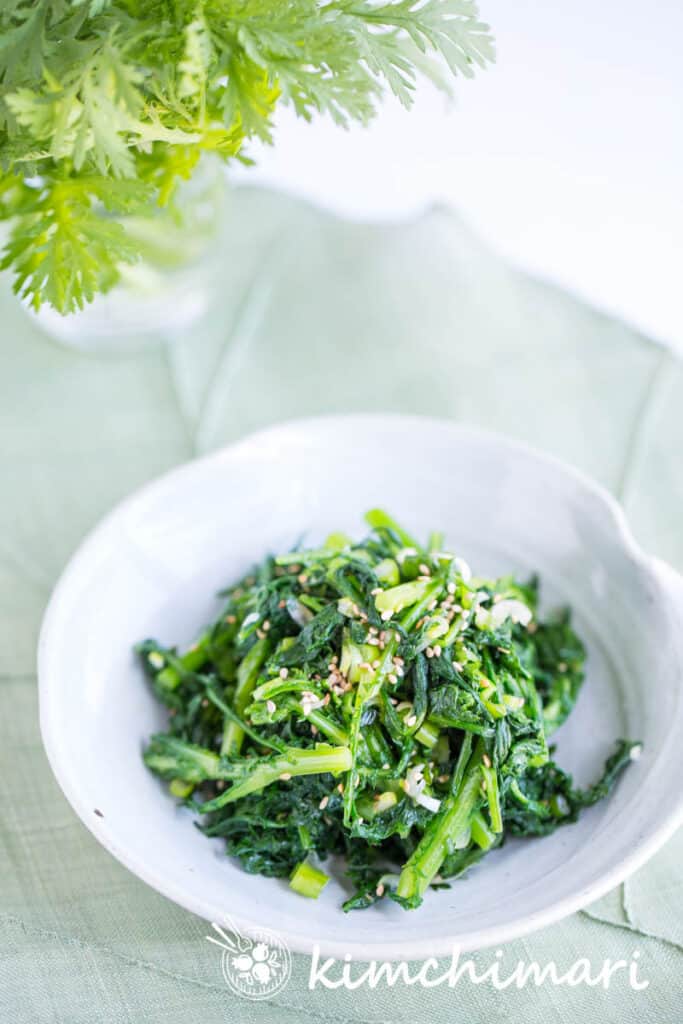
Chrysanthemum Greens (Ssukgat Namul) Side Dish
Korean Chrysanthemum Greens or Ssukat Namul 쑥갓나물 is a very simple and easy vegan banchan that Koreans love to eat in spring. Like many namuls, these crown daisy leaves are quickly blanched and then seasoned lightly.
This lovely herbaceous plant also goes by Crown Daisy or Garland Chrysanthemum and it can be eaten raw, as a garnish on soups (my favorite is on Odeng Soup) and stews (Spicy Pollock Stew) in Korean cooking. I also love topping Udon, Bibim Guksu and my Bulgogi Rice Bowl with a handful of these fresh greens.
Flavor-wise, Chrysanthemum Greens is mildly grassy, herbaceous, and has a slightly bitter aftertaste. This vegetable is also popular in other Asian cuisines and is also known to have some health benefits – high in Vitamin A, C, potassium, calcium and iron. It’s also high in dietary fiber and when you eat it as namul, you will be eating a large amount of it. (You can read more info here)
Chrysanthemum Greens in my Garden
I probably planted these Ssukgat about 5 years ago and since then these lovely greens have been reseeding themselves and have come back every year. So I was soo happy that I could make this dish just by walking out to my garden (in February in California) and simply picking them. If you want to see how I harvest Ssukat, watch the end of my fully narrated video below.
Chrysanthemum Greens/Crown Daisies/Ssukgat is a great herb to grow in your garden because when you buy them from the store, you have to buy a big bunch and they don’t last very long. Also, when you do need them, a lot of times you don’t need a whole lot so being able to pick just a few stems to use as garnish is so perfect. BTW, if you want to grow these, you can buy Ssukat Seeds online at various shops. Just search for Crown Daisy or Chrysanthemum Greens seeds.
A CLASSIC way of making non-spicy Korean Namul 나물 of starts by blanching the greens and then seasoning it mildly with just some good Korean sea salt, guk ganjang, sesame oil and aromatics like green onions or garlic. And then finishing off with sesame seeds. Koreans basically do this with spinach, minari and similar greens. It even works with broccoli or asparagus.
I LOVE this way of cooking vegetables because it really allows the flavors of the vegetable to shine and you can learn to appreciate all the delicate flavors of a vegetable.
FROM JINJOO!
Chef’s Tips for Ssukgat Namul
- Don’t Overcook – a key to making yummy namul is not to overcook the vegetable. Keep a close watch, test the doneness often and prepare an ice bath before you start cooking so that when it’s done, you can immediately transfer the veggies into the ice bath and stop the cooking. Vegetables continue to cook in hot water so it’s important to take it out of the hot pot and cool down immediately.
- Use Korean Sea Salt – I have said this before in my Korean Salt Guide post about how different the salts are – both in their taste and saltiness. In testing the recipe, I have once again experienced that the same recipe made with regular sea salt vs Korean cheonilyeom made quite a difference in flavor. Korean solar sea salt (cheonilyeom) really does make a difference in how the namul tastes. And this is especially noticed in this recipe because it has so few seasonings.
How to make Chrysanthemum Greens (Ssukat Namul)
| Servings: 4 | Cook Time: 5 min | Difficulty: Easy |
Ingredients
- 6 oz Chrysanthemum Greens (Ssukgat) or 1 bunch
- For Blanching
- 6 cups water
- 1 tsp sea salt (preferably Korean Cheonilyeom)
- 1/8 tsp sea salt (Cheonilyeom)
- 1/4 tsp Guk Ganjang (Korean Soup Soy Sauce)
- 2 green onions, chopped
- 1 tsp sesame oil
- 1 tsp sesame seeds (roasted)
Step-by-Step Instructions
- Start boiling 6 cups of water and 1 tsp salt. Note, you can cook up to 2-3 times as much ssukat in same amount of water.
- Wash and clean Chrysanthemum Greens in water and drain. The pic above shows my homegrown ssukgat greens washed and drying on my Korean wicker tray (chaeban 채반).
- Cut the thicker bottom stems into 2 inch lengths and the upper leafy parts into 4 inch or so lengths. We do this because once blanched, the leafy parts reduce a whole lot in volume while the stems still pretty much maintain their size.
- Chop green onions.
- Prepare ice bath (a bowl of cold water + a bowl of ice) to put the blanched ssukat in to stop it from cooking further.
- Once the water starts boiling in the pot, 1) add just the stem parts first into pot and cook for 1 min or so. 2) Then add the top leaves and cook for another 1-2 min until the thick stems are cooked. 3) to check if the stems are cooked enough, take one stem out and bend it between your fingers. It should bend easily without snappning. We don’t want to overcook and make it mushy and want it to be slightly crunchy. 4) When done, remove greens from pot immediately and transfter Chrysanthemum Greens into the prepared ice bath.
- Let ssukgat cool in the ice bath for few seconds then drain. Take a handful of the cooked ssukat between your hands and squeeze out excess water from them. Gently squeeze between your hands to form a ball while squeezing out the water. Once done, no water should drip from it but you also don’t want to squeeze so much as to crush the stems so be gentle but firm!
- In a bowl, add the balls of squeezed greens and undo the ball so the leaves are loosly separated. Add green onions and seasonings – Guk Ganjang, sea salt, sesame seeds and sesame oil. Use your hands (use gloves if you want) to gently massage all the seasonings into the greens. Once it’s all nicely mixed, taste and adjust if necessary.
- Serve at room temperature or cold from the fridge. This Ssukat Namul banchan will go well with any Korean dish or meal so enjoy!
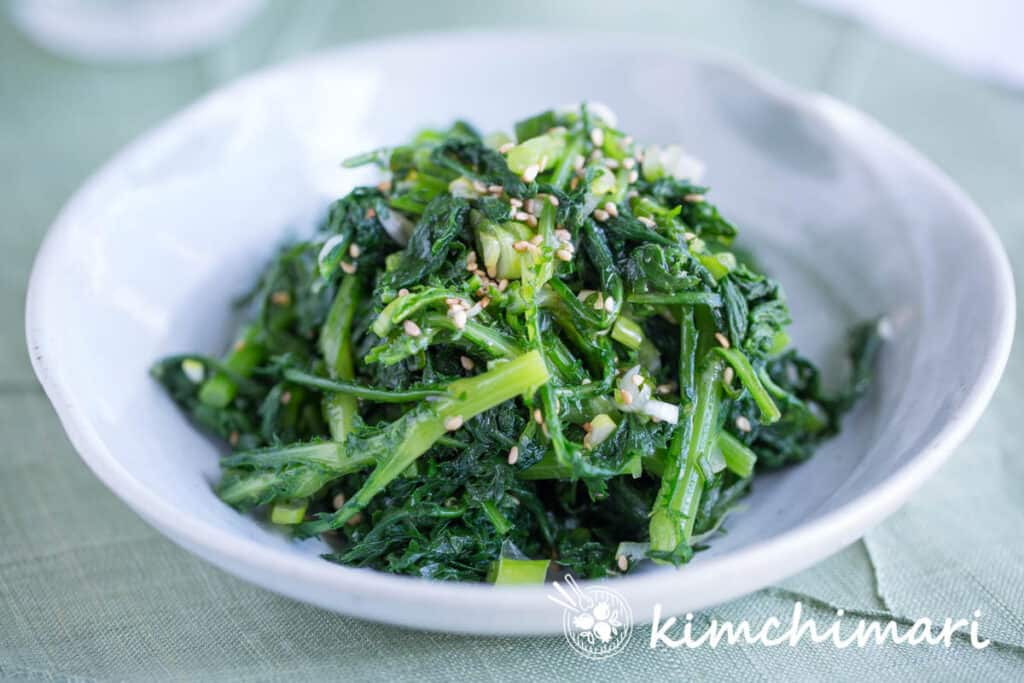
Here’s a shot of Ssukgat Namul on one of my latest favorite Korean plates designed with Korean traditional dress (Hanbok 한복).
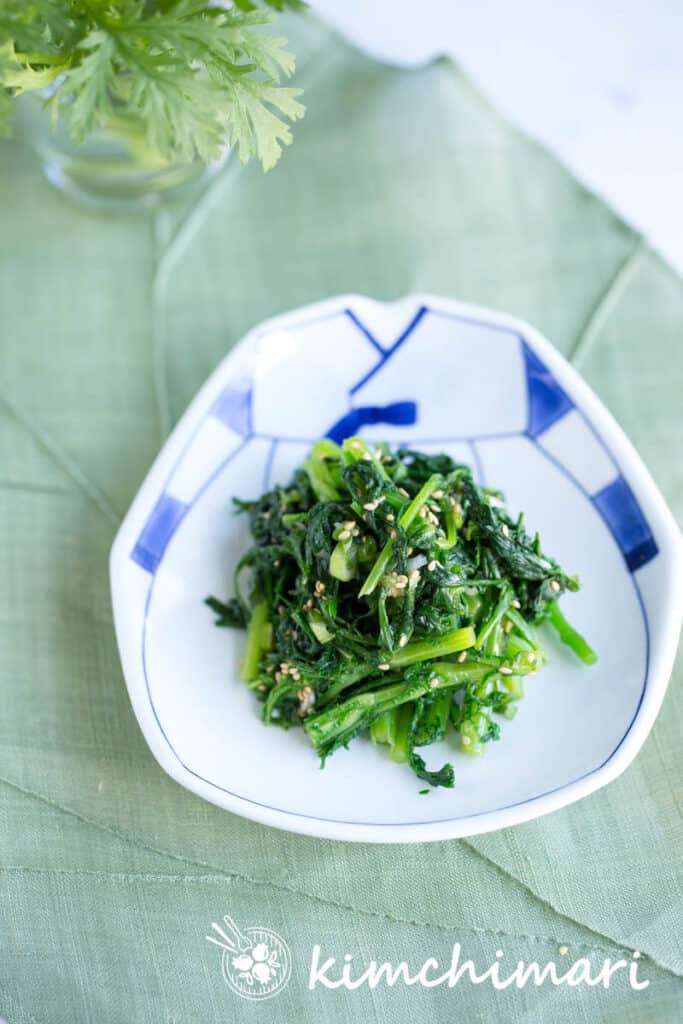
Watch my How To Video for Ssukat Namul
Ssukgat Namul (Chrysanthemum Greens)
Ingredients
- 6 oz Chrysanthemum Greens Ssukgat or 1 bunch
- 1/8 tsp Korean sea salt Cheonilyeom
- 1/4 tsp Guk Ganjang Korean Soup Soy Sauce
- 2 green onions chopped
- 1 tsp sesame oil
- 1 tsp sesame seeds roasted
For Blanching
- 6 cups water
- 1 tsp sea salt preferably Korean Cheonilyeom
Instructions
- Start boiling 6 cups of water and 1 tsp salt. Note, you can cook 2-3 times as much ssukat in same amount of water.
- Wash and clean Chrysanthemum Greens in water and drain.
- Cut the bottom stem part into 2 inch lengths and the upper leafy parts into 4-5 inch lengths. I do this because the leafy parts once blanched reduce a whole lot in volume while the stems still pretty much maitain it’s size.
- Chop green onions. Prepare ice bath (a bowl of cold water + a bowl of ice) to put the blanched ssukat in to stop it from cooking further.
- Once the water starts boiling in the pot, add just the stem parts first and cook for 1 min or so. Then add the rest of the leaves and cook for another 1-2 min until the thickest stems are cooked. You can take one out and do the bend test like so. We don’t want to overcook and make it mushy. We want it to be slightly crunchy.
- When it’s cooked, quickly remove the pot from heat and transfer the cooked chrysanthemum leaves into the ice bath. Let it cool then remove the leaves from the ice bath and put into a colander.
- Then take a handful of it between your hands and squeeze out excess water from the cooked greens. Gently squeeze but don’t wring it totally out.
- In a bowl, add the balls of squeezed greens and loosen them so the leaves are loosly separated. Now, add the green onions and seasonings – Guk Ganjang, sea salt, sesame seeds and sesame oil. Use your hands (use gloves if you want) to gently massage all the seasonings into the greens. Once it’s all nicely mixed, taste and adjust if necessary.
- Serve at room temperature or cold from the fridge. This Ssukat Namul banchan will go well with any Korean dish or meal.
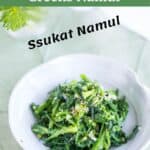
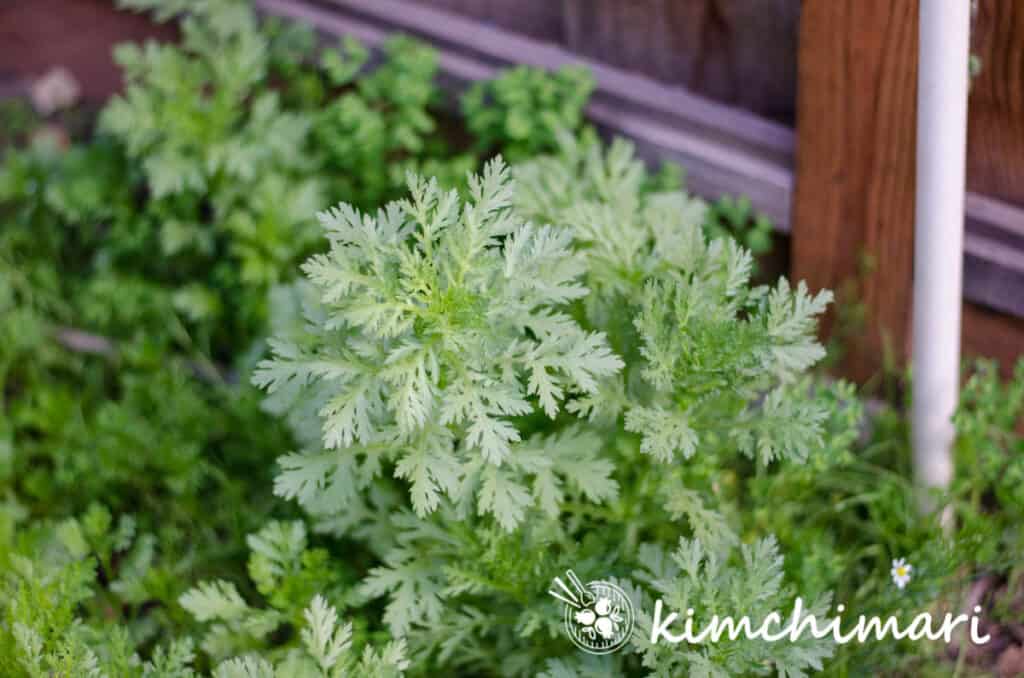
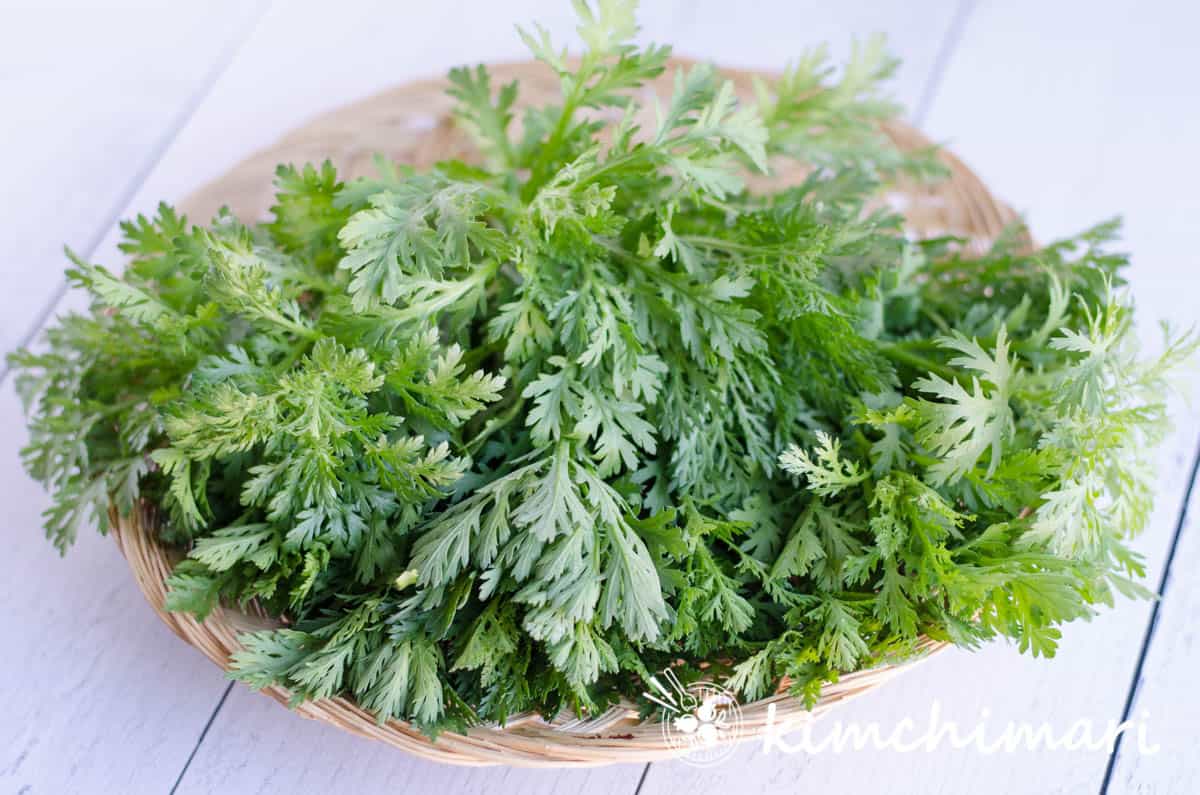
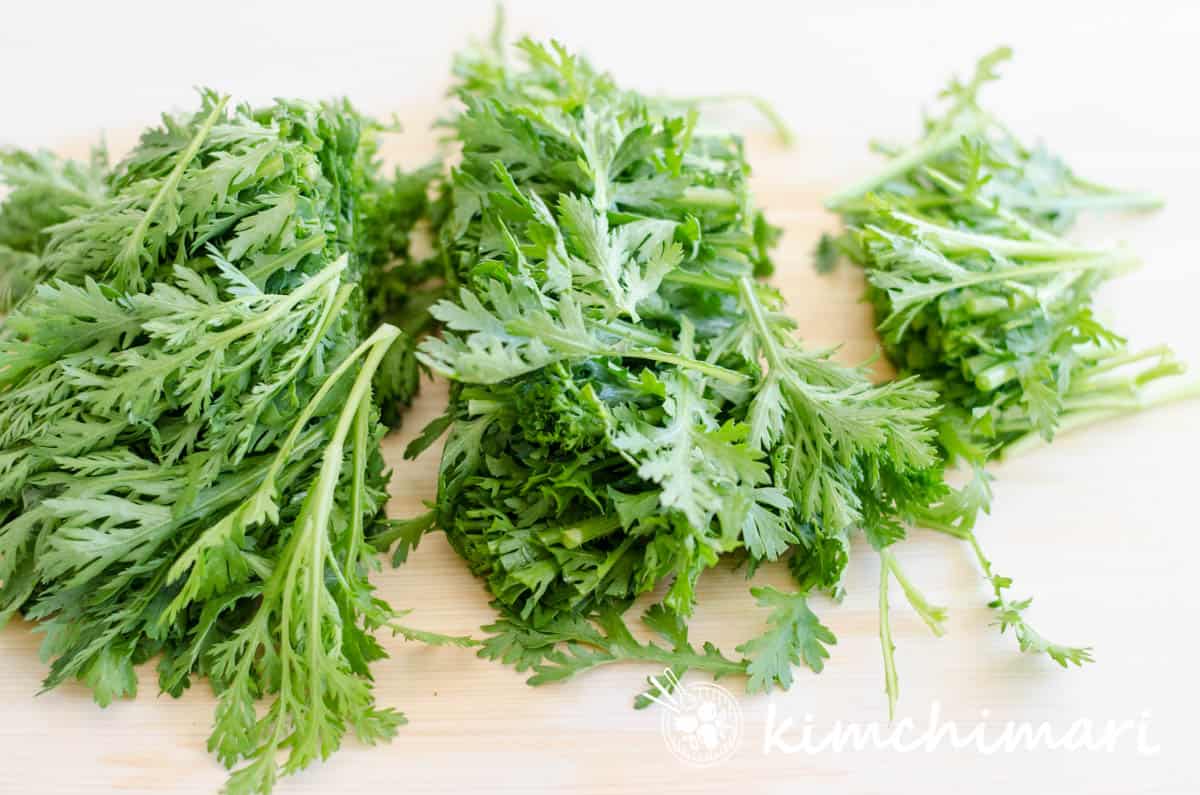
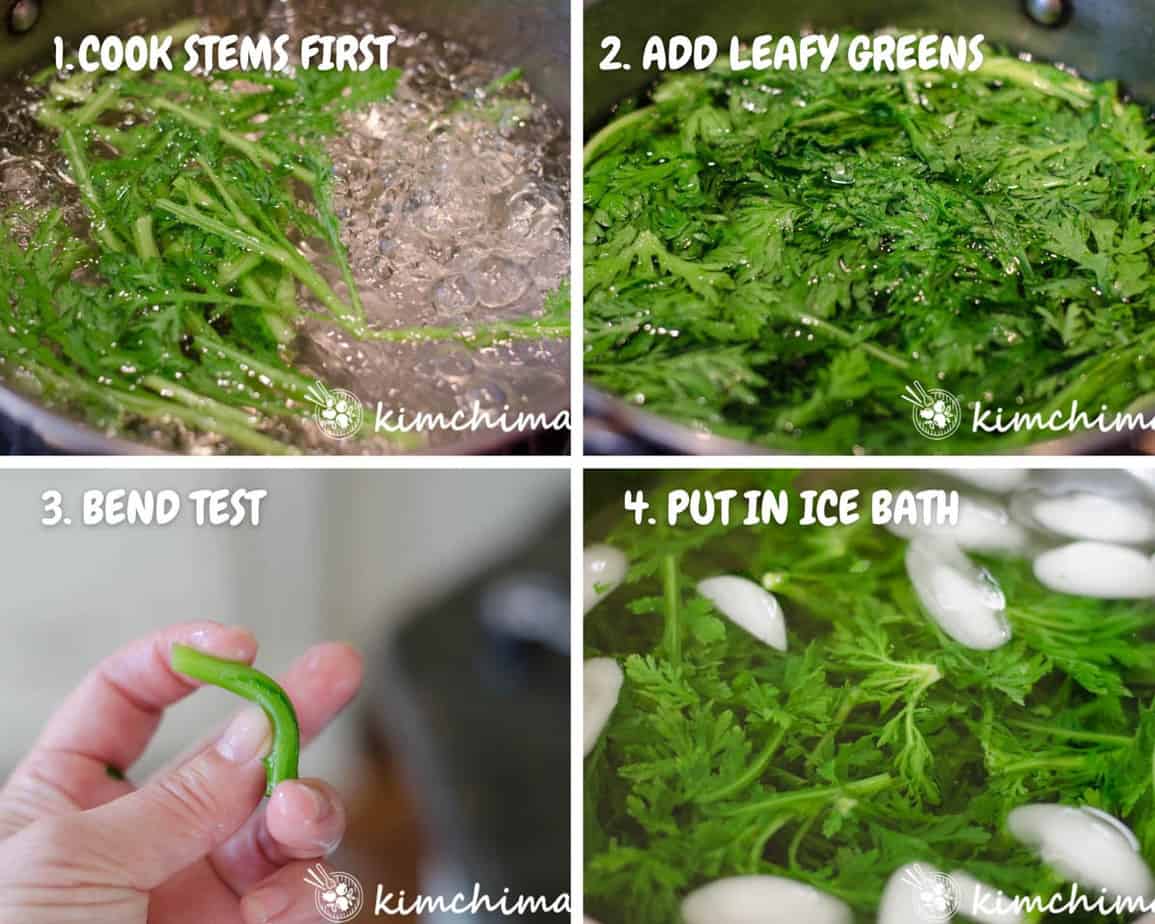
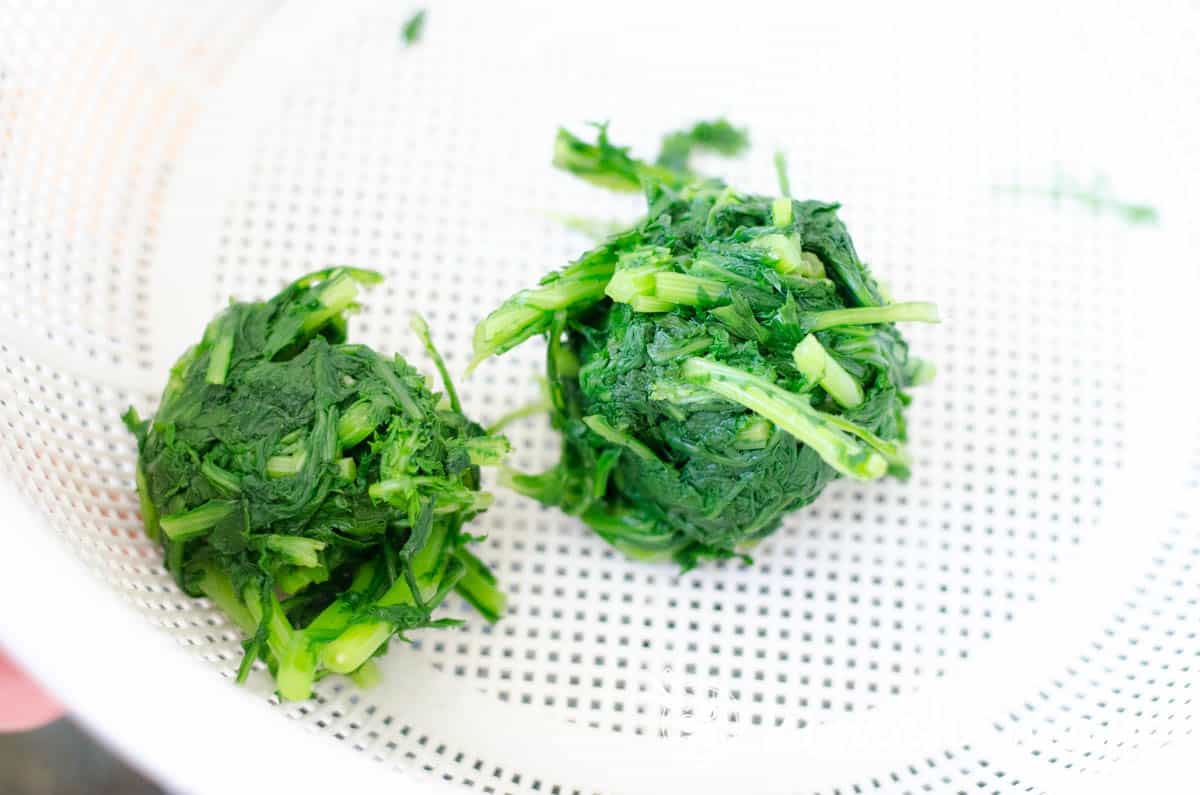
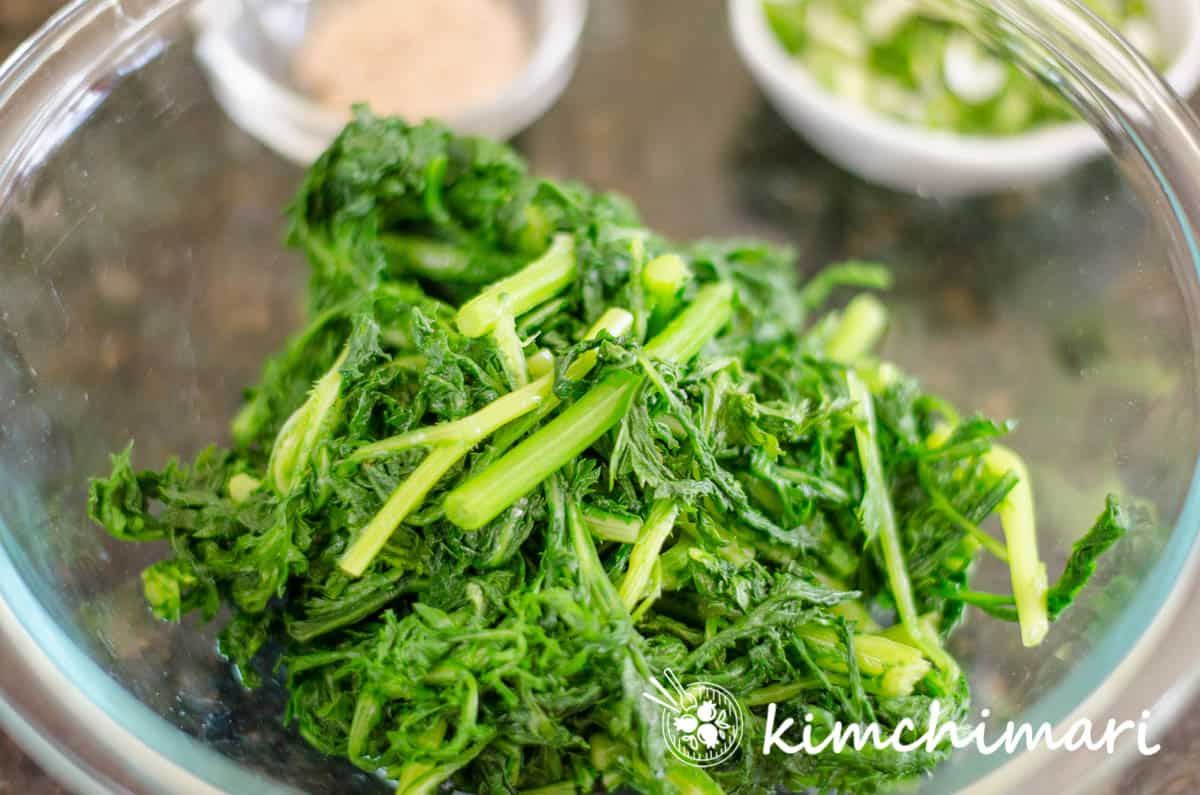
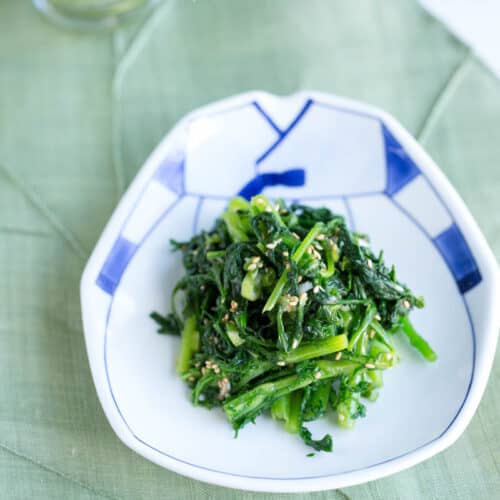
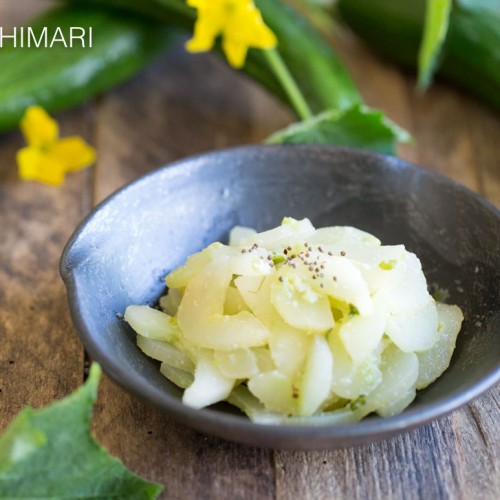
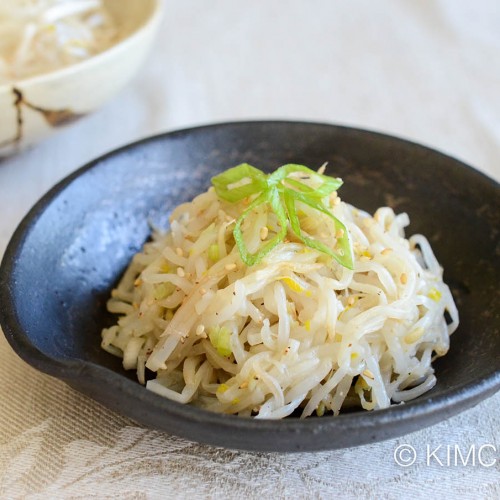
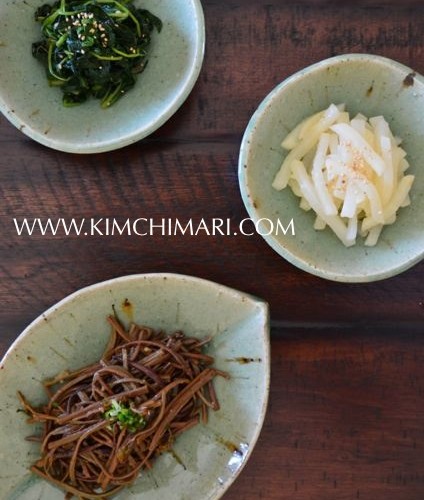

















Hi JinJoo. I happened to be in a Korean supermarket the other day while on holiday (there is not such a place where I live) and (intrigued as I was) bought a 120gr can of Korean Chrysanthemum in water. Can I use this for this recipe?
I also bought a 120gr can of Korean radish leaves in water. Same recipe? Or do you have better suggestion? I am always very interested in new tastes, but ingredients are hard to find, so on holidays I just buy something to try out 😋😋
With the best wishes and regards
Hmm.. I haven’t seen canned Chrysanthemum in water but I assume it’s already cooked? If that’s the case, yes, I believe you can just squeeze out the excess water and try my recipe. As for the can of radish leaves – again I assume then it’s wet and pre-cooked, in that case, you can make soup with it. Just use this recipe – https://kimchimari.com/radish-soup-korean-mu-doenjang-guk/, sub the leaves instead of radish. If it’s dried radish leaves, you need to soak in water for 1-2 days, simmer and cook then use it in recipe. Hope that helps. Thanks for asking!
I love this recipe so much!
this was so amazing i didnt have the exact ingredients but i had broccoli and tried it – tasted amazing
Oh yes, broccoli will work as well! In fact, any greens – as long as you don’t overcook it – will work with this recipe.
this was so amazing I didnt have the exact ingredients but i had broccoli and tried it – tasted amazing – really yummy
Oh yes, broccoli will work as well! In fact, any greens – as long as you don’t overcook it – will work with this recipe.Thank you for the 5 stars!!